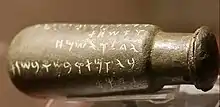Tel Siran inscription
The Tel Siran inscription is an inscription on a bronze bottle (or "situla") found at Tel Siran on the campus of the University of Jordan in Amman). It was first published on 27 April 1972. It is considered the first complete inscription in the "Ammonite language". The bronze bottle is now in the Jordan Archaeological Museum. It is known as KAI 308.

Description
The well preserved bronze bottle is about ten centimeters long and weighs about 280 grams. The clearly legible inscription is on the outside. The archaeological context suggests that the bottle was in use until the Mamluk period. The bottle is considered to have been made in the Iron Age II period, which would suggest use for 2,000 years.
The contents of the bottle were seeds of barley, wheat and grass, as well as unidentifiable metal remains. A C14 analysis found the content to be about 460 BC.[1]
The inscription
The inscription consists of eight lines of legible text. They are attached in the direction from the opening of the bottle to its bottom. Line four protrudes into this floor, while line 5 only contains a single word. It has been translated as:
May the produce of Amminadab, king of the Ammonites,
son of Hissalel, king of the Ammonites,
son of Amminadab, king of the Ammonites,
from the vineyards and the gardens and the hollow and the cistern,
cause joy and gladness for many days to come and years far off
However, the translation of mlk as "king" has been disputed, with the suggestion that it should be interpreted as "mallaka" which means "transformed ownership or sold".[2]
F. Zayadine and H. O. Thompson, the first editors, referred to the script as Aramaic script and dated the inscription paleographically to the first half of the 7th century BC.[3] F. M. Cross, on the other hand, sees the inscription as the latest stage of development of the "Ammonite language" and dates it to around 600 BC for paleographic reasons.[4][5]
References
- Joseph Azize: `` The Ammonite Bottle and Phoenician Flasks. In: `` Ancient Near Eastern Studies 40 (2003), p. 62 –79, here p. 63 f.
- https://www.academia.edu/37142062/The_three_false_kings_of_the_bottle_how_we_misunderstood_the_Ammonite_Inscription_of_Tell_Siran
- Fawzi Zayadine; Henry O. Thompson: The Ammonite Inscription from Tell Siran In: Berytus 22 (1973), pp. 115-140, here esp. P. 117.
- Frank Moore Cross: Notes on the Ammonite Inscription from Tell Sīrān. In: Bulletin of the American Schools of Oriental Research 212 (1973), pp. 12–15, here p. 13-14.
- COMMENTARY ON THE TELL SIRAN INSCRIPTION, HENRY O. THOMPSON: "The initial study suggested that the text was in the Phoenician script which relates directly to Dr. Frank Cross' judgment that the script and language are pure Canaanite. A detailed survey of published inscriptions shows that the Siran script is closest to Aramaic of c. 700 B.C. However, Cross (who is undoubtedly the world's leading expert in ancient Near East epigraphy), claims that Ammonite had an independent development from the parent Aramaic from c. 750 on. Diagnostic forms fell 100 years behind so that the Siran inscription dates c. 600 B.C. shortly before this Ammonite script was destroyed by the Babylonians and replaced by Aramaic. What is not clear in his discussion is when does a branch of Aramaic become pure Canaanite and how does a conquering army destroy a script?"